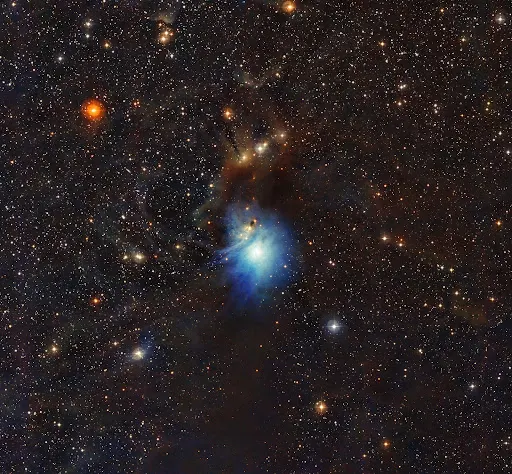IC 2631, affectionately known as the Reflection Nebula, is a breathtaking celestial wonder that captivates astronomers and stargazers alike. This stunning cosmic cloud, located in the constellation Norma, offers a mesmerizing display of vibrant colors and ethereal beauty. In this article, we will delve into the fascinating features of IC 2631 and unravel the mysteries hidden within its shimmering glow.
Reflection nebulae are unique celestial phenomena that derive their name from their ability to reflect the light of nearby stars. Unlike their more famous counterparts, the emission nebulae, which emit light of their own, reflection nebulae simply scatter and reflect the light from neighboring stars, creating a luminous spectacle. The light interacts with the nebula's dust particles, causing them to scatter the shorter wavelengths (such as blue and violet) more than the longer ones, giving rise to the characteristic blue hues often associated with reflection nebulae.
IC 2631 stands out as one of the most striking examples of a reflection nebula. Its location in the Norma constellation, approximately 570 light-years away from Earth, makes it a prime target for both amateur and professional astronomers. What sets IC 2631 apart is its intricate structure and mesmerizing color palette, showcasing a harmonious blend of blues, grays, and hints of pink.
At the heart of IC 2631 lies a cluster of young, hot stars, whose intense radiation is responsible for illuminating the surrounding nebula. These youthful stars, known as T Tauri stars, are in their early stages of formation and exhibit high levels of magnetic activity. Their powerful stellar winds and radiation bombard the nearby gas and dust, causing them to glow brilliantly and create the enchanting reflection nebula we observe.
While IC 2631's beauty is undeniable, astronomers are equally intrigued by the scientific insights it can provide. By studying reflection nebulae like IC 2631, scientists gain valuable information about the composition and structure of interstellar matter. The dust particles within the nebula, for instance, contain complex organic molecules that are crucial for the formation of stars and planets. Understanding these processes can shed light on the origins of life in the universe and further our knowledge of stellar evolution.
For astronomy enthusiasts interested in observing IC 2631, a moderate-sized telescope is sufficient to witness its ethereal glow. The nebula can be found in the constellation Norma, specifically in the southern skies, making it more visible to observers in the Southern Hemisphere. Ideally, observing IC 2631 under dark, clear skies away from light pollution will provide the best viewing experience.
IC 2631, the Reflection Nebula, offers a breathtaking display of cosmic beauty. Its shimmering blue hues and intricate structure make it a captivating sight in the night sky. Beyond its aesthetic appeal, studying IC 2631 provides valuable insights into the processes of stellar formation and the evolution of our universe. As we continue to explore the vastness of space, IC 2631 stands as a shining example of the wonders waiting to be discovered.

 Correspondent
Correspondent
